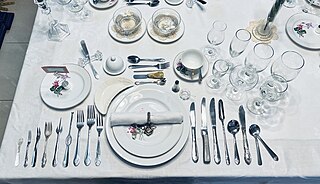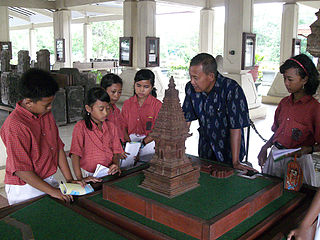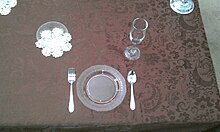
Thali or Bhojanam is a round platter used to serve food in South Asia, Southeast Asia and the Caribbean. Thali is also used to refer to an Indian-style meal made up of a selection of various dishes which are served on a platter. Thali is also used in south Asia for ceremonial purposes.

Table setting or place setting refers to the way to set a table with tableware—such as eating utensils and for serving and eating. The arrangement for a single diner is called a place setting. It is also the layout in which the utensils and ornaments are positioned. The practice of dictating the precise arrangement of tableware has varied across cultures and historical periods.

Service à la française is the practice of serving various dishes of a meal at the same time, with the diners helping themselves from the serving dishes. That contrasts to service à la russe in which dishes are brought to the table sequentially and served individually, portioned by servants.

Various customary etiquette practices exist regarding the placement and use of eating utensils in social settings. These practices vary from culture to culture. Fork etiquette, for example, differs in Europe, the United States, and Southeast Asia, and continues to change. In East Asian cultures, a variety of etiquette practices govern the use of chopsticks.

Tableware items are the dishware and utensils used for setting a table, serving food, and dining. The term includes cutlery, glassware, serving dishes, serving utensils, and other items used for practical as well as decorative purposes. The quality, nature, variety and number of objects varies according to culture, religion, number of diners, cuisine and occasion. For example, Middle Eastern, Indian or Polynesian food culture and cuisine sometimes limits tableware to serving dishes, using bread or leaves as individual plates, and not infrequently without use of cutlery. Special occasions are usually reflected in higher quality tableware.

A doily is an ornamental mat, typically made of paper or fabric, and variously used for protecting surfaces or binding flowers, in food service presentation, or as a clothing ornamentation, as well as a head covering for Jewish women and Christian women. It is characterized by openwork, which allows the surface of the underlying object to show through.

A full-course dinner is a meal with multiple courses, almost invariably enjoyed in the evening. Most Western-world multicourse meals follow a standard sequence, influenced by traditional French haute cuisine. It commonly begins with an appetizer, followed by the main course, the salad course, and eventually the dessert, but the exact sequence varies widely. Full-course dinners are generally very formal as well as very expensive, and can have as few as three courses or exceed a dozen courses. Styles of service include service à la russe and service à la française.

Charger plates or service plates are large plates used at full-course dinners and/or to dress up special events like parties and weddings. Charger plates have been in use since the 19th century.
Silver service is a method of food service at the table, with the waiter transferring food from a serving dish to the guest's plate, always from the left. It is performed by a waiter using service forks and spoons from the diner's left. In France, it appears to be now known as service à l'anglaise, although historically that meant something else, with the hostess serving out the soup at one end of the table, and later the host carving a joint of meat at the other end, and diners serving themselves with other dishes present.

A tea set or tea service is a collection of matching teaware and related utensils used in the preparation and serving of tea. The traditional components of a tea set may vary between societies and cultures.

Table manners are the rules of etiquette used while eating and drinking together, which may also include the use of utensils. Different cultures observe different rules for table manners. Each family or group sets its own standards for how strictly these rules are to be followed.
The historical form of service à la russe is a manner of dining with courses brought to the table sequentially, and the food portioned on individual plates by the waiter. It contrasts with the older service à la française, based on several courses brought to the table simultaneously in an impressive display of tureens and serving dishes with diners plating food themselves.
Etiquette rules in the United States and Canada generally apply to all individuals, unlike cultures with more formal class structures, such as those with nobility and royalty.

Letitia "Tish" Baldrige was an American etiquette expert, public relations executive and author who was most famous for serving as Jacqueline Kennedy's Social Secretary.

Chopsticks are shaped pairs of equal-length sticks that have been used as kitchen and eating utensils in most of East Asia for over three millennia. They are held in the dominant hand, secured by fingers, and wielded as extensions of the hand, to pick up food.

Customs and etiquette in Chinese dining are the traditional behaviors observed while eating in Greater China. Traditional Han customs have spread throughout East Asia to varying degrees, with some regions sharing a few aspects of formal dining, which has ranged from guest seating to paying the bill.
Hazara cuisine or Hazaragi cuisine refers to the food and cuisine of the Hazara people in Afghanistan and western Pakistan. The food of the Hazara people is strongly influenced by Central Asian, South Asian cuisines and shares similarities with neighboring regional cuisines in Afghanistan and Central Asia. However, there are certain dishes, culinary methods and styles of cooking that are unique to the Hazara people.

Various codes of etiquette in Indonesia govern the expectations of social behavior in the country and are considered very important. Etiquette demonstrates respect and is a key factor in social interactions. Like many social cultures, etiquette varies greatly depending on one's status relative to the person in question. Some conventions may be region-specific, and thus may not exist in all regions of Indonesia. The following are generally accepted contemporary customs in Indonesia.

In South Korea, etiquette, or the code of social behavior that governs human interactions, is largely derived from Korean Confucianism and focuses on the core values of this religion. In addition to general behaviour, etiquette in South Korea also determines how to behave with responsibility and social status. Although most aspects of etiquette are accepted by the country at large, customs can be localized to specific regions or influenced by other cultures, namely China, Japan, and the United States.

Japanese dining etiquette is a set of traditional perceptions governing specific expectations which outlines general standards of how one should behave and respond in various dining situations.


















